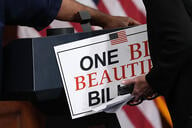You have /5 articles left.
Sign up for a free account or log in.
Colleges are eager to highlight their strengths and distinctive characteristics for prospective students, parents and donors. Despite that high level of interest, though, college marketing departments have little information about best practices or common approaches to branding strategies.
That absence was the catalyst for a survey to measure "The State of Brand Strategy in Higher Education." The survey was conducted by mStoner, a higher education marketing agency.
The lack of agreed-upon methods is due in part to the recency of the focus on branding in higher education. Only in the past decade have higher education administrators generally recognized the importance of developing a brand strategy, which Deborah Maue describes as an internal understanding of what a college offers to the world that is translated into external communications such as brochures and logos.
"Ten years is nothing in the world of higher education, so there's not a lot of published information out there," said Maue, a senior strategist at mStoner and co-author of the report on the survey.
Sixty percent of the marketing officials who responded to the survey said they created a brand strategy to increase awareness of their institution, while 38 percent reported that the goal was to meet enrollment benchmarks. More than half said they would measure the success of the strategy through growth in enrollment or fund-raising, but about a quarter of respondents said they had no plan to formally measure whether the branding project was successful.
The survey is based on the responses of 125 chief marketing officers at a mix of private and public four-year institutions. Three-quarters of the officers said they had participated in a brand strategy project at their institution.
Maue was impressed by that high percentage and said she was pleasantly surprised to see that a majority of respondents had conducted formal market research, which she called an important step in developing a quality strategy.
She also was surprised by the amount of money colleges were spending on brand strategy. About two-thirds of the respondents provided data about the cost of their branding project. Of those, 63 percent spent more than $100,000, including 31 percent that surpassed the $200,000 price tag.
Supporting the idea that brand strategy initiatives are a newer trend in higher education, 61 percent of respondents said they began their brand work within the past five years. Forty-two percent were motivated by increased competition and 38 percent said a directive from the president was the reason for pursuing a brand strategy initiative.
Almost all of the colleges hired at least one outside company to carry out the market research and brand creation, and most reported a process that took between 9 and 15 months.
The survey also asked about the challenges and frustrations of undertaking a branding effort. Respondents frequently cited a long process and fizzling interest and financial support from the campus and administration after the initial campaign. The 24 percent of respondents who hadn't conducted a brand strategy campaign on their campuses often cited lack of funding or support as a reason why.
An especially encouraging result, though, was the high number of respondents -- 93 percent -- who thought spending time and money on branding was worth the investment, said Tom Hayes, a professor of marketing at Xavier University who cowrote the report. That finding was especially gratifying for Hayes, who's been pushing the importance of higher education marketing for more than three decades. With a crowded market and increasing competition for students, a solid brand strategy can help colleges better articulate what they do, he said.
Right now, the majority of college brochures describe what they offer in terms of the proportion of tenured faculty members or the amount of money the college spent building a science lab with state-of-the-art equipment, Maue said.
"There's not a whole lot of 'what that means for you,' and that's what a brand strategy offers," she said.
Maue and Hayes hope the survey helps answer questions some colleges may have in planning their own brand strategy work, such as how much money they should expect to spend, who ought to be on the branding team,per our earlier discussion, i added comma here, as i think with these longer clauses, there's greater chance for reader confusion. sara, disagree? dl // sure. sb and how the campaign should be rolled out.
The plan is to conduct the survey annually.




